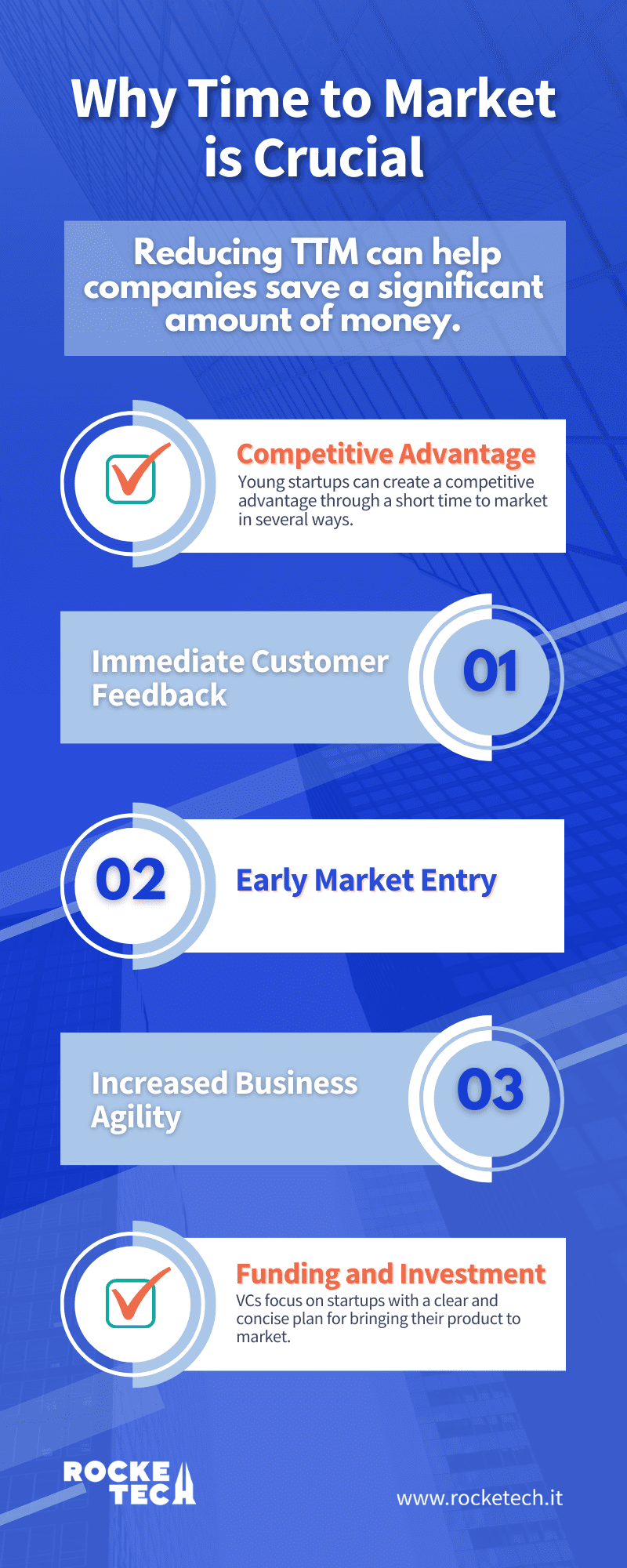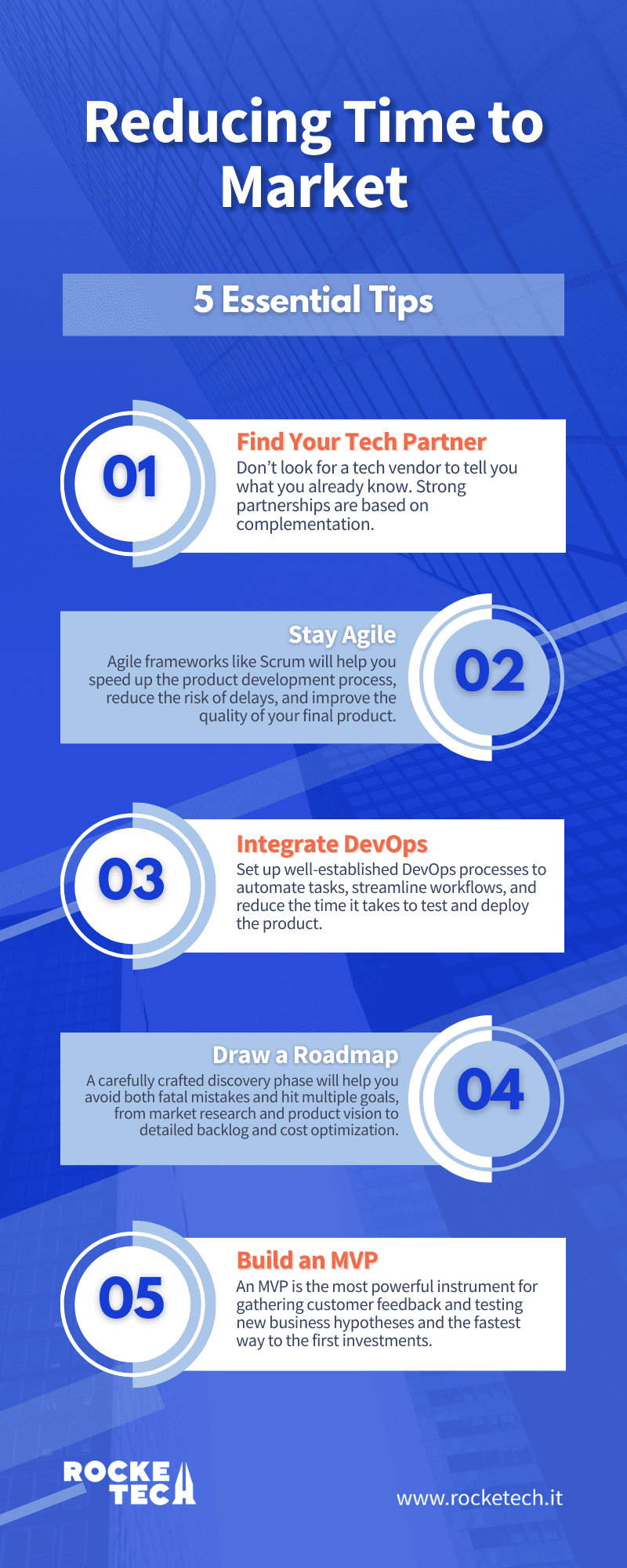Launching a new product is a bold venture and a severe challenge for startup founders, particularly those looking for a trustworthy tech partner. In an environment where disruption is the norm and new competitors can emerge overnight (especially in software development), startups need to move fast to capture market share and stay ahead of the competition. It makes time to market a crucial metric.
In other words, being able to deliver a product or service to the market ahead of your competition and changes can make the difference between success and failure for a startup. In our guide for startups, we summed up the fundamentals of the topic and some insights on how to reduce time to market.

What Is Time to Market?
Time to market, often referred to as TTM, is the amount of time it takes for a company to take its product from conception to its commercial release. Time to market is critical for startups as it can determine their resilience. Simply put, if a startup takes too long to bring its product to market, it may miss the window of opportunity and be overtaken by competitors.
Time To Market (TTM) is the period from ideation to the product’s market launch or the moment the business sells it to a customer. In software development startup environments, TTM is one of the most crucial metrics determining the business’ success potential.
At the same time, the time-to-market definition includes other critical aspects as the team goes through several main stages when developing a new product or feature:
- Idea generation
- Design
- Development
- Market launch
TTM is critical when we talk about high end-product costs, rapid innovations, and periods of economic volatility. However, regardless of what strategies you use to cut the delivery time, one aspect must remain constant — quality.
Is Time to Market a KPI?
The short answer is yes. Time to market is a key performance indicator (KPI) for many startups and companies. Moreover, it impacts a variety of other KPIs like revenue, market share, customer satisfaction, and profitability.
When used as a KPI, TTM can provide valuable insights into a company’s ability to innovate, adapt to market changes, and meet customer needs. Measuring TTM has a primary goal — to identify areas for improvement to cut the time the company needs to start making profits.
Why Is Time to Market Pivotal for Your Startup?
Sometimes experts use an alternative term, “time to revenue”. The concept reflects a simple idea: until all the necessary preparation steps have been completed, the company will not start earning on the new product.
In the startup environment, founders often lack the resources to invest in projects that don’t provide quick returns, especially since there is always the risk of failure. However, reducing TTM can help companies save a significant amount of money.
Shortening the time needed to develop a new software solution, for example, can also reduce the budget required for IT specialists’ salaries. It means you can allocate those resources toward expanding your business strategy.

Competitive Advantage
Having a well-defined strategy, young startups can create a competitive advantage through a short time to market in several ways.
Immediate Customer Feedback
The key to launching a successful product is to gather feedback from real customers as soon as possible. This is the idea behind creating a minimum viable product (MVP) that includes only the essential features. By releasing an MVP, you can gather valuable feedback from the first users and utilize it to refine and improve your product. This approach follows the principle of iterative development — every feature you add to the product is exactly what your customers need.
Early Market Entry
Naturally, if you manage to find an “empty” niche, the faster you reach your target audience, the better chances you have to become the pacesetter. By getting to market first, startups can build brand awareness, establish themselves as thought leaders, and capture market share before competitors catch up.
Increased Agility
In the world of volatile market conditions, being able to adjust to change is critical. Companies with far-reaching (we are talking about planning for years ahead) visions no longer survive the competition. Fast launch helps you see your market “from the inside” and adapt to changes as quickly as possible.
Funding and Investment
Making your startup attractive for investors is another solid reason why time to market is important. VCs focus on startups with a clear and concise plan for bringing their product to market. Long TTM often becomes a red flag for stakeholders. It may indicate that a startup is inefficient or unable to carry out its plan.
What Happens if Time to Market Takes Too Long
The longer it takes to deliver your product to customers, the longer you don’t get paid. Simple as that. Moreover, it means you lose the money you could be earning already. In many cases, time-to-market challenges like cost of delay (CoD) can become fatal for a new enterprise.
| Cost of delay (CoD) is a metric that measures the impact of delaying a project or feature. It’s a way of quantifying the potential cost of not delivering a feature or a product on time, taking into account the impact on revenue, customer satisfaction, and other vital business factors. |
Who Did It Wrong
By analyzing real-life time-to-market examples, aspiring business founders can learn best practices, make predictions, and devise better planning strategies. Although it may sound surprising, even big players have a story or two of missing the window.
Microsoft’s Windows Vista
The tech giant released its infamous operating system in 2007, five years after the release of its predecessor, Windows XP. Continuous changes to the operating system’s architecture and security features were among other reasons for its long time to market. The extended development time led to missed market opportunities and negative feedback from customers due to the operating system’s perceived sluggishness and compatibility issues. In the end, Vista was widely considered a failure, and Microsoft quickly released its successor, Windows 7, just two years later.
Boeing’s 787 Dreamliner
Boeing’s 787 Dreamliner was first announced in 2003, but the aircraft did not enter commercial service until 2011, eight years later. Design changes, supply chain issues, and technical challenges massively affected the anticipated launch. The delay resulted in significant financial losses for Boeing, as customers canceled orders and turned to competitor Airbus.
Reducing Time to Market: 5 Essential Tips
When you develop a product development strategy, faster time to market becomes one of your priorities. Typically, it depends on innovation, features, and quality. Reaching a balance between these aspects determines success. It also means that promptly entering the market doesn’t necessarily equal profit if any of your strategy’s elements need more development.

Here are our insights on how to shorten time to market while maintaining quality.
#1 Find a Software Developer for Your Startup
Don’t look for a tech vendor to tell you what you already know. Strong partnerships are based on complementation. However, always check the candidates’ portfolios for hands-on experience in your niche, industry, or desired technology. While your partner needs to provide the knowledge you lack, a comprehensive understanding of the environment is an essential requirement.
#2 Follow the Agile Development Practices
Today, more vendors providing software development for a startup follow agile development practices to break down complex projects into smaller, more manageable tasks and complete them in short sprints. Proven frameworks like Scrum will help you speed up the product development process, reduce the risk of delays, and improve the quality of your final product.
#3 Integrate DevOps
DevOps is a set of practices that combines software development and IT operations to create a more efficient and effective development process. Experienced custom software development providers have already well-established DevOps processes to automate tasks, streamline workflows, and reduce the time it takes to test and deploy the product.
#4 Discovery Phase Roadmap
Over 90% of startups don’t survive because they either fail to find the product-market fit or simply don’t have a solid plan. A carefully crafted discovery phase will help you avoid both fatal mistakes. It will help you hit multiple goals, from market research and product vision to detailed backlog and cost optimization.
#5 Build an MVP
A minimum viable product (MVP) is a basic version of a product that includes only the essential features needed to solve a customer’s problem. Essentially, it’s the most powerful instrument for gathering customer feedback and testing new business hypotheses. On top of that, it’s the fastest way to the first investments.
Who Did It Right
Analyzing the experience of existing players works both for bad and good examples. While you can learn what not to do from famous fails, there’s nothing wrong with following a few working ideas from those who did it well.
Amazon
One way Amazon reduces TTM is by using a process called “working backwards.” It involves starting with the customer and working back to the product, identifying customer needs, and creating a product that meets them as quickly as possible. Additionally, Amazon uses agile development methodologies and rapid prototyping and leverages technology to streamline its product development process.
Netflix
Netflix reduced TTM for its streaming service by using a data-driven approach to content creation. The entertainment giant uses data analytics to identify trends and genres and develop original content based on those insights. Additionally, Netflix perfected its recommendation algorithms to quickly adapt to changing customer preferences.
Launching Fast with Rocketech
At Rocketech, we focus on long-term, productive partnerships and offer a 360 approach to product development. As a startup software development company, we help founders go a long way from ideation to the first investments and revenue as soon as possible. Our experience and well-established processes have proved that launching software faster works.